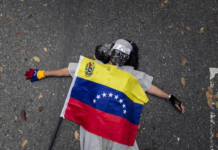[ad_1]
Iraqi
Deputy Oil Minister Fayadh al-Nema talks to journalists before a
meeting of OPEC oil ministers in Vienna
Thomson Reuters
Oil prices moved back up closer to $50 per barrel on the sudden
surge in optimism surrounding an OPEC deal. With the meeting just
days away, everybody is playing ball and sticking to the script,
and the odds of an agreement have improved markedly compared to a
few weeks ago.
Iraq offered three proposals to OPEC members, showing a renewed
willingness to negotiate after weeks of disputing production data
and demanding an exemption from the proposed cuts. Details of the
proposal were kept quiet, but Iraqi officials sounded cooperative
in an emailed statement. “Iraq’s legitimate demands should not be
perceived as an obstacle to reaching a new agreement to freeze
production,” Iraqi oil minister Jabbar al-Luaibi said, according
to Bloomberg. Iraq is optimistic about “reaching
a fair agreement that would take into consideration everyone’s
interests and that puts an end to the glut.” Officials from Iran,
Nigeria and even Russia also offered positive words about the prospects of
an accord.
Oil prices shot up by more than 4 percent on Monday on the news.
Oil has rallied once again in recent days after dropping into the
low-$40s per barrel. Now back up close to the $50 per barrel
threshold, OPEC has once again succeeded in jaw-boning the oil
market.
Goldman Sachs hiked its oil price forecast this week by a
substantial amount. The investment bank expects oil prices to
average $55 per barrel in the first half of 2017, up sharply from
the previous estimate of $45 to $50. The bank is now “tactically
bullish” on oil. “With greater confidence that the global oil
market can finally shift into deficit later next year, we now
believe that there is a strong rationale for low-cost producers
to deliver a swift production cut to normalize inventories,”
Goldman analysts wrote in a research note this week. In fact,
Goldman Sachs sees prices rising across a range of
commodities next year.
The optimism has not trickled over into the oil futures market,
at least not yet. Hedge funds and other money managers have
stepped up their short bets on crude oil ahead of the OPEC
meeting, covering against a steep downfall in prices should OPEC
fail to come to terms. While the short positions on oil were
notable, trading volume in general is way up. Bloomberg notesthat as of mid-November, oil price
volatility was at a seven month high. Bets on oil futures reached
1.47 million contracts for the week ending on November 15, the
largest trading volume in nearly a decade.
A
worker checks the valve of an oil pipe at Al-Sheiba oil refinery
in the southern Iraq city of Basra, Iraq, April 17,
2016.
Essam
Al-Sudani/Reuters
But since mid-November, oil prices have increased, suggesting
that some oil traders are closing out short positions, which
could be because sentiment around the chances of an OPEC deal
have improved. Further gains are possible as shorts are closed
out.
At the same time, John Kemp of Reuters notes that the oil futures curve still does
not look very good. The market is still in a state of contango,
in which front month contracts are cheaper than oil futures
further out. That is a sign that the markets still expect the
glut of supply to continue. In fact, the difference between front
month oil contracts and delivery six month out are actually wider
than they were back in September when OPEC reached the Algiers
agreement, which suggests an even gloomier outlook than two
months ago. In short, an OPEC agreement might spark a short-term
rally, but unless they agree to real and sustained cuts, the poor
fundamentals could ensure the price increases are temporary.
That last point is also key. OPEC may agree to something, but the
details matter. OPEC is now producing at least 236,000 barrels
per day (as of October) more than they were in September. That
means that instead of needing to cut between 200,000 and 700,000
barrels per day in order to reach the stated goal of bringing
output down into the range of 32.5-33.0 mb/d, OPEC will now need
to make even sharper cuts – somewhere on the order of 600,000 to
1.1 mb/d. On top of that, the latest reports suggest that OPEC is discussing a six
month agreement rather than one that would last a year. The idea
is that it would require less of a sacrifice for OPEC members,
particularly for Iraq and Iran who are still holding out. Of
course, if OPEC cuts for six months and then the agreement
expires, the effort will produce very little in the way of
balancing the market.
Finally, assuming OPEC does the unthinkable and actually agrees
to substantive and sustained cuts in output, they will likely
succeed in pushing up oil prices. But that then merely throws a
lifeline to U.S. shale, which could come back to life if oil
prices move closer to, say, $60 per barrel. Even today, with
prices below $50 per barrel, the rig count has been climbing for
half a year, and now stands at 588 rigs as of last week, up
almost 200 rigs from May. Gains in the rig count will only pick
up pace if OPEC agrees to cut its output.
[ad_2]
fuente








